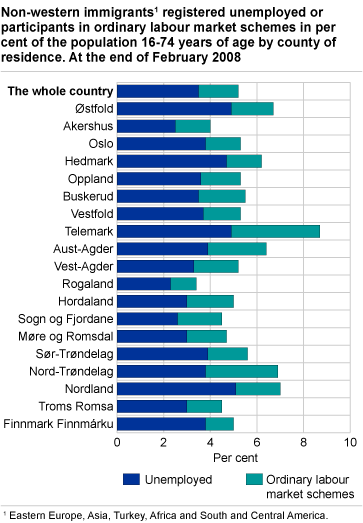Content
Published:
This is an archived release.
Continued fall in immigrant unemployment
Registered unemployment among immigrants fell from 5.9 per cent to 4.5 per cent from February 2007 to February 2008. In the rest of the population, registered unemployment fell from 1.8 to 1.4 per cent.
10 092 immigrants were registered unemployed in the first quarter of 2008, a decline of 1 500 from the corresponding period last year. Three years ago the unemployment rate among immigrants was 10 per cent. Thus the rate has been more than halved during this period.
|
Immigrants are defined as first-generation immigrants, i.e. born abroad by foreign-born parents. They must be registered as settled in Norway for at least six months. The figures are based on the Directorate of Labour's register of job seekers and are calculated as a fraction of the labour force. |
Stable differences
In relative terms, the decrease in unemployment was similar in all groups. Thus the registered unemployment rate among immigrants continues to be three times higher than in the majority population. This difference has been stable for a long time and is to some extent due to the relatively large number of immigrants who are newcomers on the labour market. Thus the proportion of employed in the labour force is somewhat lower in this group compared to the majority population. As long as there is immigration at a certain level this also applies in periods of low unemployment. A complete equalisation of the unemployment rates is therefore not realistic due to these structural factors.
Differences among immigrant groups unchanged
Within the four non-western groups the decline in unemployment varied between 1 and 2 percentage points. Asian immigrants had the largest decrease in relative terms. Immigrants from Africa had the highest unemployment rate at 10.6 per cent. Immigrants from Asia had the second highest rate at 5.9 per cent, while the unemployment rate for immigrants from Eastern Europe (except EU countries) and South and Central America was 5.5 per cent and 4.5 per cent respectively. Immigrants from western regions had an unemployment rate slightly below 2 per cent while those from the EU countries in Eastern Europe had 2.4 per cent unemployed.
Slightly higher unemployment among women
The unemployment rate for male and female immigrants was 4.4 per cent and 4.6 per cent respectively. In the rest of the population, the unemployment rate was 1.5 and 1.3 per cent. This is contrary to traditional gender differences in registered unemployment among immigrants, where men usually have a higher unemployment rate than women. This new pattern is probably due to an increase in female job seekers due to favourable labour market conditions.
Few descendants registered unemployed
Only 317 descendants, defined as people born in Norway by foreign-born parents, were registered unemployed in February 2008. The majority were aged 16-29 years, and in this group the unemployment rate was 2.6 per cent, which was almost at the same level as the corresponding age-group in the population as a whole.
Participants on labour market schemes slightly increased
Despite the falling unemployment rate, there was a slight increase in the number of immigrants on ordinary labour market schemes (job programmes) from 4 310 in February 2007 to 4 484 in February 2008. In total, 11 550 people participated in labour market schemes. In the majority population, there was a decline of 500 participants. The immigrant participants had mainly non-western background.
As a percentage of the immigrant population, the participation rate was 1.3 per cent in February 2008 compared with 1.4 per cent in the previous year. Hence, the slight increase in the number of immigrant participants has not resulted in an increase in the participation rate. In the rest of the population, the participation rate was only 0.2 per cent. Immigrants from Africa had the highest participation rate at 3.1 per cent.
Tables:
- Table 1 Registered unemployed, by immigrant background, region of birth and sex. In absolute numbers and in per cent of the labour force in each group. By the end of February 2007 and 2008
- Table 2 Participants on ordinary labour market schemes (job programmes), by immigrant background, region of birth and sex. Absolute numbers and in per cent of persons aged 16 to 74 years. By the end of February 2007 and 2008
- Table 3 Registered unemployed, by region of birth and time of residence in Norway. By the end of February 2008 and 2008. Absolute figures and in per cent of persons in total aged 16-74 years
- Table 4 Registered unemployed, by immigrant background, region of birth and county of residence. Absolute numbers and in per cent of persons aged 16 to 74 years in each group. By the end of February 2007 and 2008
- Table 5 Participants on ordinary labour market schemes (job-programmes), by immigrant background, region of birth and county of residence. Absolute numbers and in per cent of persons aged 16 to 74 years in each group. By the end of February 2007 and 2008
- Table 6 Registered unemployed, by sex, immigrant background, region of birth and age. Absolute numbers and in per cent of the labour force in each group. By the end of February 2007 and 2008
Additional information
The unemployment figures are based on the Norwegian Labour and Welfare Organisation’s register of jobseekers and are calculated as a share of the labour force, which is the sum of employed persons and registered unemployed persons, i.e. people offering their labour on the labour market.
Contact
-
Statistics Norway's Information Centre
E-mail: informasjon@ssb.no
tel.: (+47) 21 09 46 42

